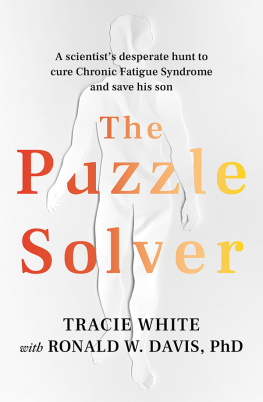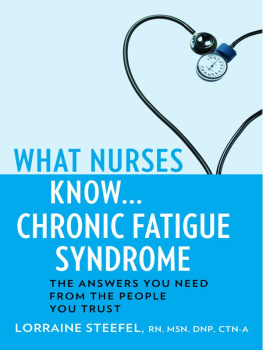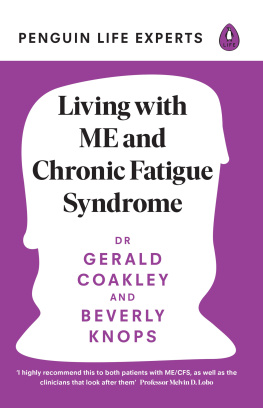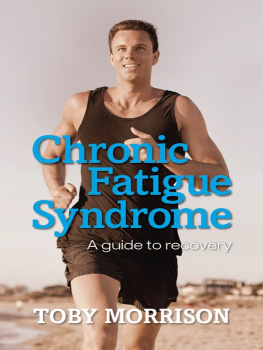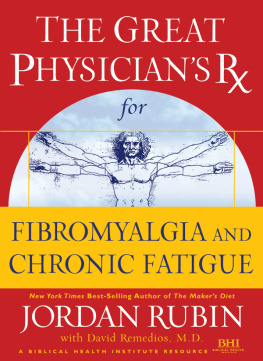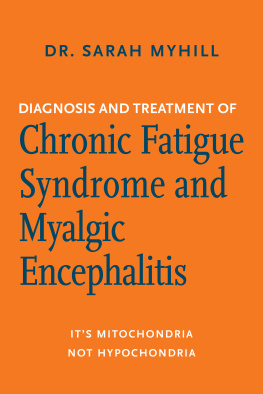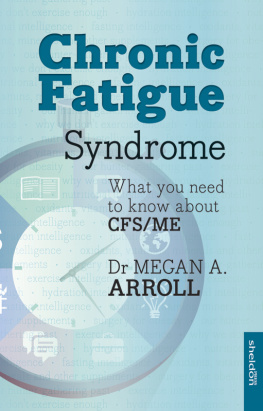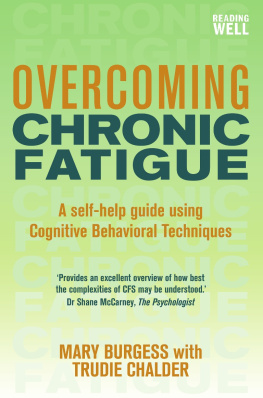Tracie White is an award-winning journalist and a science writer for Stanford University. Her work, which has garnered 23 writing awards, has also appeared in Salon, the Los Angeles Times, the San Francisco Chronicle, and more. She graduated from UC Berkley and has a masters degree in journalism from Northwestern University. She lives in Aptos, California.
Ronald W. Davis, PhD, has been called one of the worlds greatest living inventors by the Atlantic. He is a professor of Biochemistry and Genetics at Stanford University and director of the Stanford Genome Technology Center. He has won numerous awards for his research, including the Gruber Prize in genetics for his groundbreaking contributions to the field of genomics. He now is devoted to finding a cure for Myalgic Encephalomyelitis/Chronic Fatigue Syndrome (ME/CFS).
First published in Australia and New Zealand by Allen & Unwin in 2021
First published in the United States in 2021 by Hachette Book Group, Inc.
Copyright Tracie White 2021
All rights reserved. No part of this book may be reproduced or transmitted in any form or by any means, electronic or mechanical, including photocopying, recording or by any information storage and retrieval system, without prior permission in writing from the publisher. The Australian Copyright Act 1968 (the Act) allows a maximum of one chapter or 10 per cent of this book, whichever is the greater, to be photocopied by any educational institution for its educational purposes provided that the educational institution (or body that administers it) has given a remuneration notice to the Copyright Agency (Australia) under the Act.
Allen & Unwin
83 Alexander Street
Crows Nest NSW 2065
Australia
Phone: (61 2) 8425 0100
Email:
Web:www.allenandunwin.com

ISBN 978 1 76087 569 5
eISBN 978 1 76106 097 7
Cover design: Milan Bozic
Cover illustration: Getty Images
For Whitney
Contents
Everyone knows someone with a mysterious illness that goes unmentioned and gets ignored. Often, its a chronic disease with no known cause and few treatments. The illness simply refuses to dissipate. As years pass, doctors grow frustrated; families grow weary. The sick grow hopeless. A curtain falls, to hide the unimaginable and enduring pain. And silence remains. This is an attempt to lift the curtain from over those sick people who go unseen, untreated, and forgotten. But this book will also bring those sick, and the ones who love them, hope.
Whitney Dafoe, a young fine arts photographer who traveled the world, now has one of those ongoing illnesses that often gets ignored. Once he was healthy and strong, but an illness crept up on him slowly, incrementally taking away bits of his life. First it took away his energy, then his ability to walk any farther than the few steps to his bathroom. Eventually he could no longer talk or eat. He couldnt leave his room or even bear to have others join him there. Symptoms of severe fatigue, gastrointestinal problems, muscle pain, and neurological disorders plagued him for years before he even got a diagnosis. He was told there was nothing wrong with him, that he was crazy, that if he exercised hed be fine. Finally, eight years ago, he got a diagnosis. He has chronic fatigue syndrome, now known as ME/CFS, a disease with no known cause, no approved treatments, and no cure. And still, it strikes twenty million people worldwide.
Yet the course of this story has changed due to Whitneys father, a legendary Stanford University scientist. Ron Davis, whose discoveries helped launch the Human Genome Project, is now on the hunt for the prey that took his son away. Beginning with a drop of his own sons blood, he launched a search for the cause and, from there, a treatment and a potential cure for this often forgotten and stigmatized disease.
ME/CFS, like many other illnesses, usually strikes healthy people out of the blue, changing their lives forever. It brings fear and uncertainty, like AIDS or the coronavirus. Most go undiagnosed. One quarter get severely ill like Whitney, bedridden or unable to leave their homes. Many lose their jobs, and even family and friends. Without a definitive lab test to diagnose the disease, they are often disbelieved by doctors and face obstacles getting medical insurance or disability. No one knows just how many end up homeless.
Despite a new acceptance within the scientific community as a biological disease, the illness is still little known with not much funding for research. Patients are still mocked for being nothing more than tired, or lazy, or crazy. Once called the yuppie disease, it remains hidden away, with a long and winding, messy history that also must be unveiled.
Ron Davis has used his prestige within the scientific community to speak out, share his new research discoveries on this disease, and tell his sons story, the same story that millions of others have suffered and continue to suffer. Its a story that needs to be told.

IN DECEMBER 2016, SOMETIME in the middle of the night, Whitney Dafoe slowly used Scrabble tiles to spell out this:
Cant take care of myself. Dont know what to do.
This was followed with five more tiles: D...Y...I...N...G.
Then he pushed a button next to his bed that rang a bell throughout the house to summon his parents, who were caring for him around the clock, to his room.
Later, when I asked his father, Ron Davis, a legendary scientist, how he responded when he saw what his son had spelled out in tiles, he simply said, I did not answer himhe cannot tolerate anyone speaking to him.
That week, Whitney was taken in an ambulance to the hospital to get a feeding tube inserted into his abdomen. He needed it to stay alive.
Two months later, I drove up to Ron Daviss home in Palo Alto, California, for the first time on a chilly winters evening. A gentle breeze touched my cheek as I climbed out of my old, green Honda Civic, but my heart felt heavy. I had come to interview Ron and his wife, Janet Dafoe, to hear Whitneys story. (Whitneys parents, I would also learn, chose to share their last names between their two children. Whitney has his mothers last name, and their daughter, Ashley, was given her dads.) Over several decades as a journalist, I had gained a reputation as the go-to writer for tragic stories, so it was natural my editor at Stanford Medicine magazine had assigned me this story about a father trying to save his severely ill son.
Id written articles for the magazine before about amputees who survived the 2010 Haitian earthquake, Cambodian refugees with PTSD, the deplorable lack of health care on Native American reservations, and myriad other science stories about horrific medical conditions and the search for cures. I was proud to be able to give a voice to these often neglected stories, but I also had a personal motivation. Id been devastated myself decades before by a late-term miscarriage. The grief eventually lifted, but it left me with a chronic case of insomnia that I struggle with still. Along with that came a growing obsession with writing stories about people living with chronic conditions. I wrote about cancer and Alzheimers disease, clinical depression and foster children living with PTSD. Id look into peoples eyes when I interviewed them, searching for answers. How did they do it? How did they carry on?

